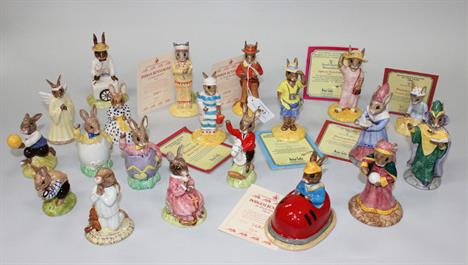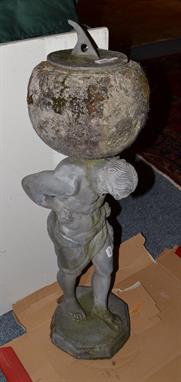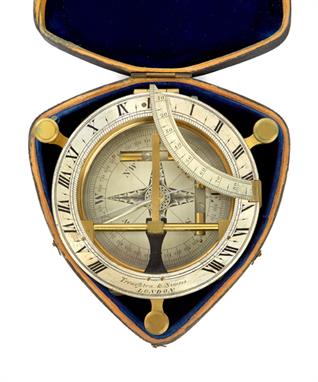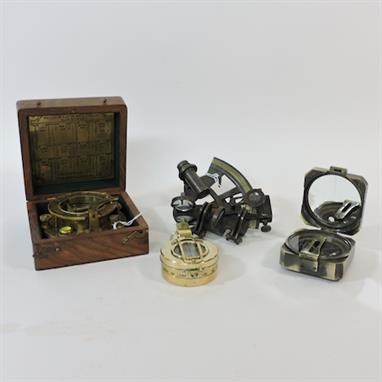We found 5735 price guide item(s) matching your search
There are 5735 lots that match your search criteria. Subscribe now to get instant access to the full price guide service.
Click here to subscribe- List
- Grid
-
5735 item(s)/page
A 5`` Bronze Sun Dial, possibly dated 1660, on a sandstone fluted column with scroll capital and rough carved base, 142cm high overall Provenance: thought to be the sundial erected by Robert Towneley in 1662 at Carr Hall, Barrowford. For further reading see Blakey (Jesse) The Annals and Stories of Barrowford, pg.193, para.3 which refers to a sundial Gnomon missing and extensive weathering. 190214
A 5`` Bronze Sun Dial, possibly dated 1660, on a sandstone fluted column with scroll capital and rough carved base, 142cm high overall Provenance: thought to be the sundial erected by Robert Towneley in 1662 at Carr Hall, Barrowford. For further reading see Blakey (Jesse) The Annals and Stories of Barrowford, pg.193, para.3 which refers to a sundial Gnomon missing and extensive weathering. 190214
A collection of twenty Royal Doulton Bunnykins figures, comprising `Cowboy`, DB201, `Indian`, DB202, both with certificates and boxed, `Dodgem`, DB249, `Mother`, DB189, `Seaside`, DB177, `Sightseer`, DB215, `Tourist`, DB190, `Sundial`, DB213, all with certificates and boxed, `Ice Cream`, DB82, `Fortune Teller`, DB218, `Mystic`, DB197, `Angel`, DB196, `Susan`, DB70, `Polly`, DB71, `Tom`, DB72, `Harry`, DB73, `William`, DB69, `Bedtime`, DB55, `Easter Greetings`, DB149, and `Easter Surprise`, DB225, with seven boxes.
A FINE UNIVERSAL COMPASS SUNDIAL BY TROUGHTON & SIMMS, LONDON, with 3in. silvered dial engraved with compass rose, two spirit levels and needle with clamp, hinged chapter ring signed as per title, with folding gnomon and latitude arm, supported on three threaded feet and contained within original blue plush-line sharkskin case with maker’s instruction sheet folded within -- 6in. (15cm.) diameter
A BRASS SUNDIAL BY J. GILBERT, LONDON, 1776, finely engraved with subdivided chapter ring divided in Roman numerals IV-XII-VIII, signed and dated J. GILBERT, TOWER HILL, LONDON, 1776, foliate compass rose and substantial gnomon, the underside with wooden peg feet -- 14in. (35.5cm.) diameter, John Gilbert (w.1751-91) was the second of three ‘John Gilberts’ in this famous family firm operating from premises in Tower Hill. It was unusual for them to date their instruments. Amongst their many apprentices was Peter Dollond.
A BRONZE ARMORIAL SUNDIAL BY HEATH & WING, LONDON, CIRCA 1770, signed as per title by ‘north’, compass rose to centre, chapter ring divided III-XII-VIII, armorial device at south and original gnomon -- 11¾in. (30cm.) diameter, The armorial device is believed to be that of the Rouse-Boughton family, the ninth baronet was Sir Charles William Rouse-Boughton (1747-1821), an administrator in the East India Company, and latterly an MP in Pitt the Younger’s administration.
Ansonia Clock Co. (USA) Sunwatch Pocket Sundial lacquered tin with gold finish and white backed compass inset, with Tables of Latitudes inside lid and `C H Ellis` scratched onto front and back, an unmarked three draw telescope with 1.25``, 3cm lens 19.5``, 50cm; and a Spectroscope (cased) (3) All originally belonging to C Hamilton Ellis the railway author and painter
A fine and rare William and Mary double-horizontal carved Portland stone and bronze sundial circa 1690 inscribed and constructed for latitude 52° 24’ N., bearing the Arms and motto of the Cornwallis family, signed Henricus Wynne Londini Fecit, the dial plate seated on three bronze bearings upon a Portland stone plinth with octagonal top and four volute supports with acanthus terminals flanking scallop shells, on moulded square base Sundial 69cm.; 27in diameter, plinth 130cm.; 51ins high The double-horizontal sundial, as the name implies, is a dual instrument, its principal features comprising a ‘double’ gnomon and complementary hour-scales on the dial plate. The primary instrument is the fiducial edge of the inclined or sloping part of the gnomon, which, when the sundial is correctly set, lies parallel to the earth’s polar-axis and aligned in the north/south plane of the meridian and the shadow of which indicates the time against the outer hour-scale on the dial plate, in hours and minutes. The secondary instrument is the sharp vertical edge of the triangular-shaped support to the gnomon, which lies in the axis of the observer’s zenith, and the shadow of which indicates the position of the sun at the point where the straight edge of the shadow intersects the hour-line on a planispheric projection of the celestial sphere, corresponding to the time indicated on the main dial. This observation provides various astronomical data, including the sign of the zodiac in which the sun is situated, the times of sunrise and sunset, the length of the day in terms of the number of hours in the day from sunrise to sunset, the altitude and azimuth (direction) of the sun, together with the means to determine the time when certain ‘fixed’ stars would transit the meridian. The Cornwallis double-horizontal sundial has a floreated gnomon, seated on a sheet-brass dial plate, which is affixed to a cast-bronze base by means of ‘hidden’ rivets. The dial plate is engraved with various scales and tables, the primary hour-scale in the outer ring being graduated in hourly, ten-minute, five-minute and one-minute intervals, within which there are inner rings calibrated to indicate direction in terms of azimuth or bearing. The planispheric projection is also engraved with an inner and outer hour-scale, to facilitate its use, being graduated with hour-angle divisions (meridians) and parallels of declination to the limits of 23½ degrees north or south of the celestial equator or equinoctial line. Two engraved arcs, representing the ecliptic, the apparent path of the sun, extend from the points where the 6 o’clock meridians or hour-circles cut the equinoctial and graze the north/south extremities of the projection at the tropics of Cancer and Capricorn. The signs of the zodiac are inscribed at their respective intervals along these two arcs. At the east/west extremities of the projection there are date-scales, graduated in months and days, whereby the date may be determined from an observation. Conversely, the date being known, the sundial may be readily be orientated and aligned in the meridian, without recourse to the more usual and protracted methods involved in setting up an ordinary common or garden horizontal dial. Other scales engraved on the dial include a semi-circular lunar hour-scale (situated within the arc of the inner hour-scale of the planispheric projection), by which the time may be deduced from an observation of the moon, and two sets of altitude scales, for use with a pair of compasses or dividers. The names of certain fixed stars are inscribed within the boundaries of these scales, together with the values of their respective hour-angles or angular distances measured eastwards of the so-called first point of Aries, the vernal equinox. On the planispheric projection this is the point, at the eastern extremity of the grid system,
†The Crowther Collection: After John Van Nost: A lead sundial of a kneeling Moor 2nd half 20th century with octagonal lead dial 140cm; 55ins high A North American Indian and similar Blackamoor were originally made for Hampton Court by John Van Nost the Elder in 1701. They were perhaps originally intended as part of a larger set representing the Continents but for the death of William III two months after the erection of the first two.
A LARGE RARE 19TH CENTURY OCTAGONAL SLATE SUNDIAL, dated 1835, inscribed Horizontal Sundial Systematically calculated for the north latitude degrees and minutes, west longitude, degrees and minutes, the Marines Compass, the twelve signs, the primary planets rectified, the dial profusely inscribed with countries and cities of the world, towns and cites of Ireland, signs of the zodiac, months, hours, minutes are bond inscribed, "A table of the equation of time showing how much a good pendulum watch or clock ought to be faster or slower by a sun dial mathematically calculated for everyday in the year in minutes and seconds for the Meridian". 23.5 in (60cm) (1)
-
5735 item(s)/page


















































